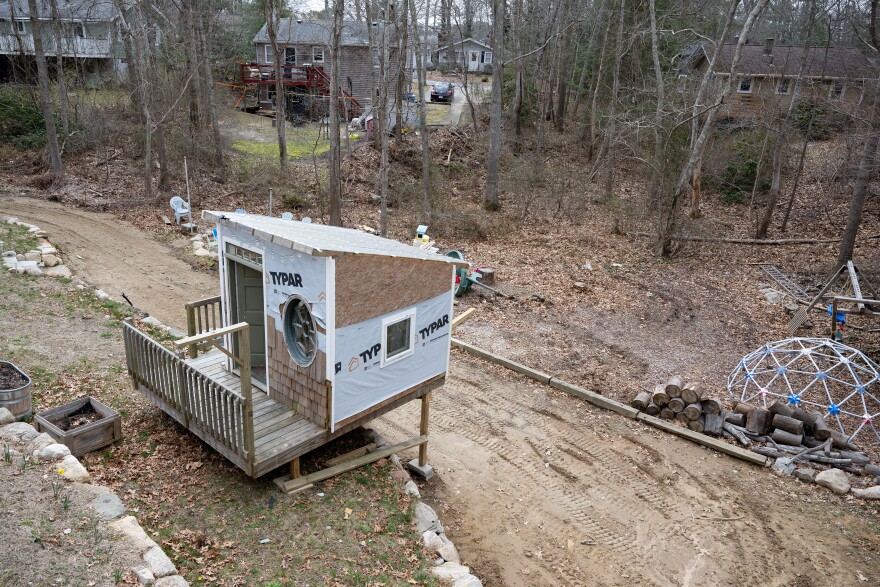In a humble garage on Cape Cod, Ann Jarosiewicz squeezed behind a refrigerator and bathroom vanity to thumb through a stack of doors.
“I mean, that's a beautiful antique door, right?”
She and Liz Prete are founders of a building materials recycling company called “.” And on a sunny April morning, they found themselves surrounded by all the stuff they’ve pulled out of homes slated for gutting, demolition, or major renovation.
It’s not just doors, but also “heat systems, hot water heaters,” Jarosiewicz said, pointing to each around the garage. “Kitchen cabinets – we’ve placed a lot of kitchen cabinets – a lot of dishwashers.”
“Dishwashers – that’s why we don’t have any here,” Prete agreed.
Since leaving their jobs as developers and starting WasteNot in 2017, Prete and Jarosiewicz said they’ve diverted from landfills over an acre of hardwood flooring, roughly 570 kitchen cabinets, and 500 windows.
Homeowners pay them for deconstruction and get a tax-write off for whatever the WasteNot team donates – which is nearly everything.
“You come across these materials and they’re still useful,” Jarosiewicz said. “And it just feels crappy to throw this stuff in a Dumpster because you know somebody somewhere needs it.”
Small companies like WasteNot are part of what could be a giant climate solution. Every day in New England, homes are built, remodeled and demolished. Nationally, we generate roughly each year, according to a 2018 report by the EPA. Experts say if we can reduce the amount we throw away from our renovation and building projects – everything from carpeting to drywall to roofing – we can save space in landfills, cut down on emissions, and fight climate change.

“Methane emissions from landfills are one of the key drivers of global warming. And … 40% of the volume of our landfills are just construction [and demolition] waste. So this is an enormous problem,” said Felix Heisel, who teaches architecture and directs the at Cornell University.
“The built environment is one of – if not the – key driver of many of the really negative impacts that are happening right now: climate change, social injustice — this is all sort of packaged in there,” he said.
At the Circular Construction Lab, Heisel is studying ways to cut greenhouse gas emissions over the course of a building’s life. That can happen by heating and cooling it with renewable energy, and by building it with sustainable and secondhand materials.
“We’re also not wasting … all the hard work that went into making these materials,” he said. “And then on the other side, we're preventing all of the emissions that come from the production of new materials and from the transport of new materials.”

The older stuff can also be much higher quality than what can be found at a big box store.
In New England, it can be hard to know where to look for good used construction materials, but there are resources like online, and can be a place to start finding windows, door knobs, and more. Eric Jolliff, a community engagement coordinator in , Maine, said his ReStore has seen more interest.
“Our revenue in our ReStore is up considerably over the past number of years,” Jolliff said. Compared to before the pandemic, he said, the store is on pace to beat its revenue “by double.”
At the ReStore in , ���ϳԹ���, assistant manager Adriana Ferraiolo said she’s hearing a few reasons why.
“The most common [reason] I see is, first, price. Obviously, it’s a lot cheaper than buying new. And then second [is] quality,” she said. “And I definitely have been seeing a lot of younger people come in and … the environment, usually they mention [that] a lot.”

The founders of WasteNot, the company on Cape Cod, said protecting the environment is a plus, but the most rewarding part of their work is helping people.
A few miles from the company’s storage garage, a Falmouth family has benefited from WasteNot’s efforts – and the evidence is spread across their home.
“So this flooring came out of a different house,” Jarosiewicz said as she entered the home. “And this is repurposed granite. Is this not cool?
WasteNot helped the family with an addition for an in-law suite, using cabinets, flooring, and granite countertops that were carefully stripped from nearby tear-downs.
“We built it for my mom to live in when she can't live on her own because she has Parkinson's,” said Colleen Allard, the homeowner.

In the backyard, a few extras have gone into a 10x10 playhouse made with a transom window, corrugated roof and pale shingles that Allard said she expects her children and foster children to enjoy for years to come. The secondhand materials saved her thousands of dollars, and already, she said, her daughters use the playhouse almost daily.
“It’s a cool story that this door and window came from some really old house,” Allard said. “What other kid has a playhouse that looks like that?”
“It’s custom,” Jarosiewicz said with a smile.
All of what ended up with Allard’s family was once destined for the landfill. Instead, in her home, what might have been tossed is now treasured.
This story is part of the ’s Earth Week series.




